Rajasthan Board RBSE Class 11 Biology Chapter 25 Families of Angiosperms
RBSE Class 11 Biology Chapter 25 Multiple Choice Objective Questions
Question 1.
Which character is same in Malvaceae, Solanaceae and Liliaceae?
(a) Axile placentation
(b) Numbers of stamens
(c) Presence of epicalyx
(d) Presence of stamina tube
Question 2.
Which plant is named as fire of forest or dhak or tesu or palash?
(a) Coronopus
(b) Cassia
(c) Butea
(d) Thespesia
Question 3.
Name the bacteria found in nodules of subfamily Papilionateae:
(a) Clostridium
(b) Azatobactor
(c) Rhizobium
(d) Cynobacteria
Question 4.
Trimerous epicalyx is characteristic of which family?
(a) Malvaceae
(b) Solanaceae
(c) Fabaceae
(d) Liliaceae
Question 5.
Mimosa pudica is commonly known as:
(a) Touch me not
(b) Candytuft
(c) Khejari
(d) Gulmohar
Answer.
1. (a)
2. (c)
3. (c)
4. (d)
5. (a)
RBSE Class 11 Biology Chapter 25 Very Short Answer Questions
Question 1.
What do you mean by epicalyx?
Answer :
The number of bracteoles varies from 3 to many; they form a whorl of epicalyx below the calyx.
Question 2.
What do you mean Tetradynamous stamens?
Answer :
When Androecium consists of 6 stamens in which two lateral and short stamens form outer whorl and 4 median and long stamens form inner whorl are called Tetradynamous.
Question 3.
Draw the labelled of the show cross form petals in Cruciferae.
Answer :
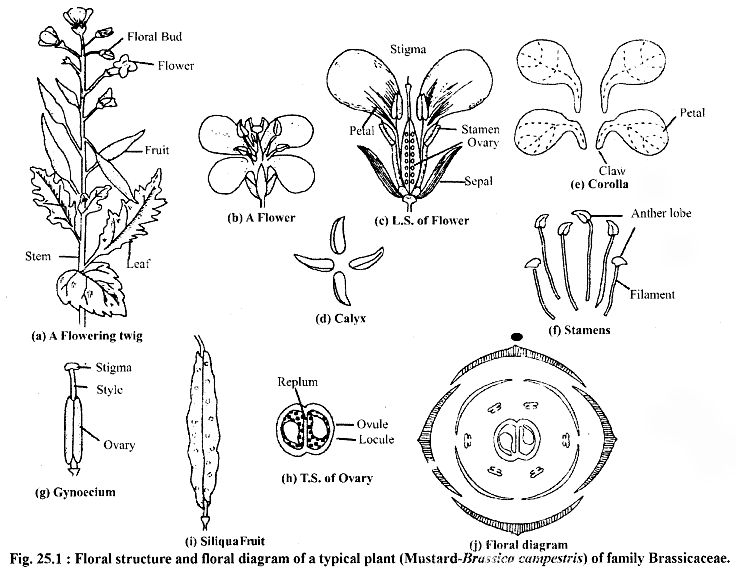
Question 4.
Explain monoadelphous and didelphous condition.
Answer :
When filaments of all stamens fused are called monoadelphous which when all stamens forms two bunches are called didelphous.
Question 5.
Write floral formula of Solanaceae.
Answer :
Br. Or Ebr
![]()
Question 6.
Write the botanical name the plant ‘Mulhati’ used in coughing.
Answer :
Glycyrrhiza glabra
Question 7.
What do you mean by persistent calyx?
Answer :
When sepals remain attached with fruit after fertilization are called persistent calyx.
Question 8.
Name the disease for which roots of Ashwagandha is used.
Answer :
A drug called asgandh is extracted from the roots. It is used in the treatment of hiccup, cough and rheumatism
Question 9.
Which plant of Liliaceae is used as raticide?
Answer :
Powder of bulbs from Urginea indica used to kill rats (Raticide)
Question 10.
Why Khejari is called as tree of heaven?
Answer :
Every part of plant is used by local peoples of Rajasthan.
RBSE Class 11 Biology Chapter 25 Short Answer Questions
Question 1.
What do you mean by Papilineocious corolla?
Answer :
- Class – Dicotyledones
- Sub-class – Polypetalae
- Series – Calyciflorae
- Order – Rosales
- Family – Leguminosae
- Sub-family – Papilionaceae
Question 2.
What were the bases to divide family Leguminosae in to subfamilies?
Answer :
It has been divided into 3 sub-families on the basis of characters of corolla (aestivation), androecium and floral characters
Question 3.
Write distinguish characters of Mimosoideae.
Answer :
Actinomorphic, Valvate aestivation. Stamens are indefinite and free
Question 4.
Write the floral formula of a flower having actinomorphic symmetry, bisexual, hvpogynous, 5 gamoseplous, 5 polypetaous, 5 polyandrous, bicarpellary and superior ovary.
Answer :
![]()
Question 5.
How can you separate the ovaries of Leguminosae from Liliaceae? Write the identification characters.
Answer :
In Leguminosae ovary is monocarpellary marginal placentation whicle in Liliaceae tricarpellary and axilc placentation.
Question 6.
Write the characteristics of androecium from Malvaceae family.
Answer :
Androecium has indefinite stamens.They are monadelphous. Filaments of the stamens are united to form a long staminal tube or staminal column which encloses the style. Basal part of the staminal tube is fused with the petals; thus stamens are epipetalous Anthers are monothecous. reniform. dorsifixed and extrorse.
Question 7.
Explain epipetalous stamens with suitable example.
Answer :
When stamens are fused with petals are called epipetalous. Example is China rose.
Question 8.
Write the botanical name of two plants and two distinguish characters from Cruciferae family.
Answer :
Plants of this family have sulphur contain mercapton compounds which are pungent in smell. Corolla is Cruciform, Stamens are Tetradynamous, Gynoecium is bicarpallery. syncarpous, ovary is unilocular which further divided it into two locules by false septum or replum. Parietal placentation. Fruit is siliqua or siliqula Examples: Brassica oleracea var botrytis, Brassica oleracea var capitata. Brassica oleracea var gongylodes
Question 9.
Write the name of family on the basis of following characters:
a. Zygomorphic, didelphous and marginal placentation in a flower.
b. Epiclayx present, stamens are infinite, monoadelphous and axile placentation.
c. Cruciform corolla, stamen’s are tetradynamous and parietal placentation.
Answer :
(a) Papilionaceae
(b) Malunceae
(c) Brassicaceae
RBSE Class 11 Biology Chapter 25 Essay Type Questions
Question 1.
Explain in detail Cruciferae family with its floral characters. Draw floral diagram and write floral formula.
Answer :
Floral Characters :
1. Inflorescence :
- Usually Racemose, Raceme (e.g.. Mustard), some have Corymb (e.g., Candytuft)
2. Flower :
- Flowers are Ebracteate (without bract), pedicillate. complete, bisexual, usually actinomorphic but in Candytuft (Iberis amara) flower is zygomorphic.
- Hypogvnous and bimerous or tetramerous flower
3. Calyx :
- Sepals are 4 in numbers, polysepalous (sepals are free), arranged in two whorls of two in each whorl, imbricate aestivation, deciduous.
4. Corolla :
- Petals are 4 in numbers, polypetalous (petals are free), cruciform (petals are diagonally arranged in the form of a cross), valvate aestivation, each petal is differentiated into a lower claw and upper expanded limb.
- In Coronopus petals are absent while in Candytuft two anterior petals are larger than two posterior petals hence it is zygomorphic.
5. Androecium :
- Androecium consists of 6 stamens. Polyandrous, Tetradynamous (2+4). two lateral and short stamens form outer whorl and 4 median and long stamens form inner whorl.
- Anthers are bithecous (Dithecous), basifixed and introse.
- Sometimes 4 nectariferous glands are present near the base of the stamens.
6. Gynoecium :
- Bicarpellary ovary, syncarpous, unilocular in early stages but later becomes bilocular due to formation of a false septum or replum.
- Ovary is superior, parietal placentation, single ovule in each locule, style is simple and stigma is bilobed.
7. Floral formula :
![]()
8. Fruit :
- Mostly siliqua type but in Capsella, Iberis and Alyssum siliqula type of fruit.
9. Seed :
- Ex-albuminous or non endospermic, cotyledons are oily.
10. Pollination :
- Self pollination and cross pollination both exists in this family . Cross pollination usually by insects.
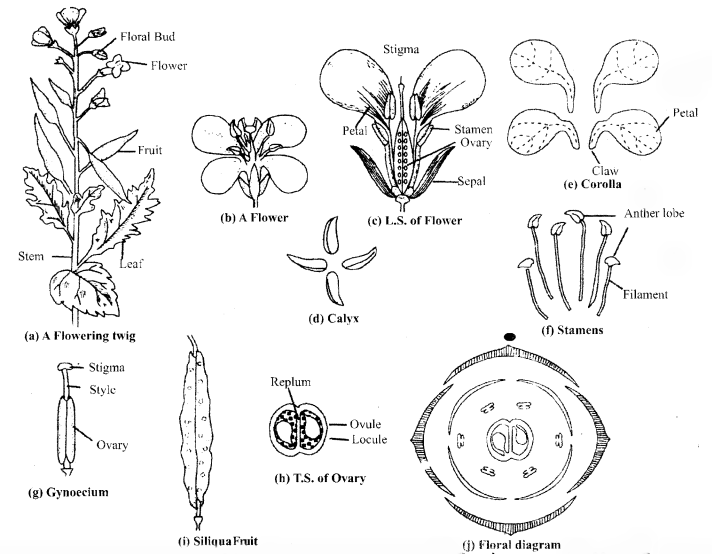
Floral structure and floral diagram of a typical plant (Mustard-/Brassica campestris) of family Brassicaceae.
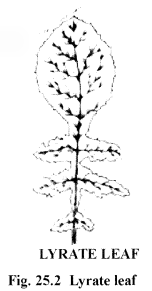
Question 2.
Write economic importance of family Malvaceae.
Answer :
Distinguish characters of Malvaceae
- Mostly epicalyx is present.
- Aestivation of corolla is twisted.
- Stamens are indefinite, monoadelphous and forms staminal tube.
- Anther lobes are monothecous, renniform, extrorse.
- Stigmas are as many as the number of carpels.
- Axile plantation.
- Mucilage secreting glands present in plants.
- Stellate hairs are present on vegetative parts of plants.
Question 3.
Do comparative study of all three subfamilies of Leguminosae and write the name of three economically important plants with its botanical name from each.
Answer :
Sub-family Papilionaceae :
- Class — Dicotyledones
- Sub-class — Polypetalae
- Series — Calyciflorae
- Order — Rosales
- Family — Leguminosae
- Sub-family — Papilionaceae
Distribution :
- This sub-family includes 490 genera and 12000 species which are cosmopolitan in distribution but mostly present in tropical and subtropical areas.
- In India the sub-family is represented by 100 genera and 750 species.
- Arachis hypogaea (Peanut), Cicer arietinum (Gram), Dalbergia sissoo (Shisham), Pisum sativum (Garden pea), Glycine max (Soyabean) and Trigonella foenum- graceum (Fenugreek) are some familiar examples of this sub-family.
Vegetative Characters :
1. Habit
- There are mostly herbs (e.g., Melilotus, Cajctnus cajan. Medicago, Trigonella, Crotalaria).
- Climbers: Plants which move up by tendril are called as climbers (e.g., Lathyrus, Pisum)
- Twiners: Plants which moves up by twisting around- some support (e.g., Clitoria, Dolichos, Phaseolus).
- Shrubs: few are shrubs (e.g., Cajanus cajcm (Arhar), Crotalaria juncea, Butea)
- Trees: Dalbergia. Erythrina.
- Xerophytes: A Ihctgi pseudoalhagi.
2. Roots
- Tap root, roots have nodules in which Nitrogen fixing bacteria Rhizobium lives as Symbiotic association to convert atmospheric nitrogen into nitrite or nitrate to increase fertility of soil so these roots are also called as nodulated roots.
3. Stem
- Stem is herbaceous or woody; sometimes weak, tendril or leaf climber.
- It is erect, creeping, branched, cylindrical and angular.
4. Leaves
- Leaves are alternate and stipulate.
- The leaf base is swollen that called pulvinus.
- Reticulate venation.
- In Medicago, Trifolium stipules are adnate.
- In Cajanus and Sesbania stipules are free-lateral.
- In Desmodium gyrans (Indian Telegraph plant) two lateral leaflets of trifoliate leaf regularly moves up and down at 180° angle by autonomous movement of variation.
- In Pisum and Lathyrus odoratus upper leaflets get modified into tendrils while in Lathyrus aphaca (Wild pea) complete leaf get modified into tendril.
- They are simple (e.g., Alysicarpus), palmately compound (e.g., Melilotus. Trifolium) or pinnately compound (e.g., Sesbania, Dalbergia, Lathyrus)
Floral Characters :
1. Inflorescence
- Racemose type of inflorescence.
- Racemose raceme in e.g., Pisum, Melilotus alba
- Spike in Uraria
- Axillary Head in Trifolium
- Solitary axillary in Lathyrus, Cicer arietimim
- Racemose of cymes in Tephrosia.
- Panicled raceme in Dalbergia
2. Flowers
- Flowers are bracteate, bracteolate, pedicellate, complete, cyclic, bisexual, zygomorphic pentamerous.
- They are usually hypogynous or slightly perigynous.
3. Calyx
- Calyx is made of 5 sepals which are united (gamosepalous)
- Odd sepal is anterior.
- The aestivation is valvate or imbricate.
4. Corolla
- Corolla consists of 5 petals.
- They are polypetalous and characteristically papilionaceous. Aestivation is Vexillary or descending imbricate.
- The odd posterior petal called standard or vexillum, is the largest. The two lateral ones, called wings, are relatively smaller, and the two anterior ones, called keel or carina, are united to form a boat-shaped structure.
- In Lespedeza corolla absent.
5. Androecium
- Androecium consists of 10 stamens.
- They are usually diadelphous, 1+ (9) e.g, Peanut (Arachis hypogea). Shisham (Dalbergia sissoo).
- Sometimes all the stamens are united in a single group, i.e., monadelphous (e.g., Crotalaria, Pongamia).
- Rarely, the stamens are polyandrous (e.g., Sophora).
- Anthers are dithecous, dorsifixed and introrse.
6. Gynoecium
- Gynoecium is monocarpellary.
- The ovary is superior, unilocular and has many ovules on ventral sutures. In Lespedeza the ovary has only a single ovule..
- Plantation is marginal.
- The style is simple, single and long. Stigma is capitates. In Pisum stigma is sword shape.
7. Floral Formula
![]()
8. Fruit
- Fruit is a legume (pod) or a lomentum.
- In Arachis hypogaea (ground nut) the lomentum is geocarpic. i.e., it develops underground.
- In Dalbergia the fruit is indehiscent and winged; the wings developing from the fruit wall.
9. Seed
- The seeds are exalbuminous or non-endospermic.
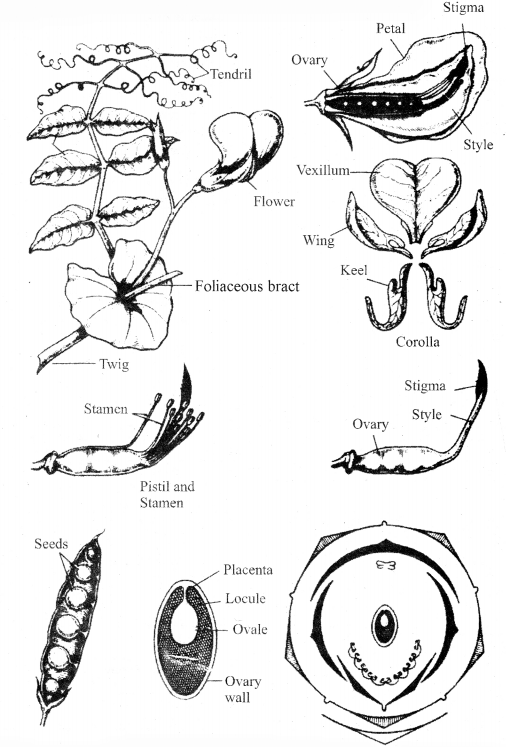
Floral structure and floral diagram of family Fabaceae (Lathyrus odoratus)
10. Distinguish characters of Papilionaceae
- Flower is zygomorphic.
- Aestivation is descending imbricate or vexillary.
- Corolla is Papilionaceous.
- Stamens diadelphous
- Root nodules with Rhizobium bacteria in roots.
Economic Importance :
- Economically, Papilionaceae is one of the most important families of angiosperms.
- All pulses belong to this family.
- Pulses are rich in proteins. Besides pulses, the family also provides vegetables, oils, food, medicines and timber.
Question 4.
Explain vegetative characters of family Solanceae. Write its economic importance also.
Answer :
Vegetative Characters :
1. Habit:
- Most of the plants are herbs or shrubs and rarely trees from this family.
- Annual herbs – Nicotiana
- Perennial herbs – Withania somnifera
- Shrubs – Cestrum (Night blooming Jasmine)
- Small tree – Solanum verbscifolium
- Climbers – Solanum jasminoides, S. dulcamara
2. Root :
- Tap root.
3. Stem :
- Usually the stem is erect, solid, cylindrical and branched.
- Occasionally, it is spinous (e.g., Solanum xanthocarpum, Datura stramonium, Lyclum).
- In potato (Solanum tuberosum) underground stem is modified into tubers.
4. Leaf :
- Leaves are alternate, exstipulate and simple with entire or lobed margins.
- Cauline, unicostate reticulate venation. Leaf surface is hairy.
- In tomato (Lycopersicon) and potato the leaves are pinnately compound.
Question 5.
Explain in detail floral characters, floral formula of solanceae. Draw its floral diagram also.
Answer :
Floral Characters :
1. Inflorescence :
- Cymose type of inflorescence which may be:
- Dichasial cyme in Datura
- Halicoid cyme in Solanum nigrum
- Scorpioid monochasium in Atropa belladonna and Hyoscyamus niger.
2. Flower :
- Flowers are bracteatior, ebracteate. pedicellate, complete, actinomorphic, cyclic, bisexual (rarely unisexual, e.g., Withcmia coagulans), pentamerous and hypogvnous.
- In Hyoscyamus, Salpiglossis and Schizanthus flowers are zygmorphic.
3. Calyx :
- Calyx consists of 5 sepals. They are gamosepalous.
- Aestivation is valvate or imbricate.
- The sepals are usually persistent but in Brinjal sepals are macrescent and in Physalis it is acerescent.
4. Corolla :
- Petals are 5, gamopetalous and show valvate or twisted aestivation.
- Corolla may be of various shape such as:
- Campanulate in Physalis
- Funnel-shaped in Petunia and Datura
- Rotate in Solatium sp.
- Bilabiate Schizanthus
- Tubular in Cestrum (Night blooming Jasmine)
5. Androecium :
- Stamens are usually 5.
- They are epipetalous and polyandrous.
- Heterodynamous. anther lobes are dithecous, basifixed and introrse.
- Dehiscence of anther lobes takes place by longitudinal slits, e.g., Datura but in Solanum it is apical pores.
- In Salpiglossis there are four stamens whereas Schizanthus has only two.
6. Gynoecium :
- Gynoecium is bicarpellary, syncarpous, forming a superior bilocular ovary.
- In some plants like Nicandra ovary is tetra or pentacarpellarv.
- Each locule has many ovules on axile placentation.
- Members of Solanaceae are characterized by the presence of an obliquely placed septum in the ovary and highly swollen placentae. The oblique septum is probably due to shifting in the position of the ovary at 45° clockwise rotation from its median position.
- In Datura the ovary becomes tetralocular due to the formation of a false septum.
- In Capsicum the lower portion of the ovary is multilocular whereas the upper portion is unilocular.
- Style is simple and the stigma is bilobed or capitate.
- A nectariferous disc is usually present at the base of the ovary.
7. Floral Formula :
![]()
8. Fruit :
- Fruit is usually a berry but in some members (e.g.. Datura, Petunia) it is a capsule.
9. Seed :
- Albuminous
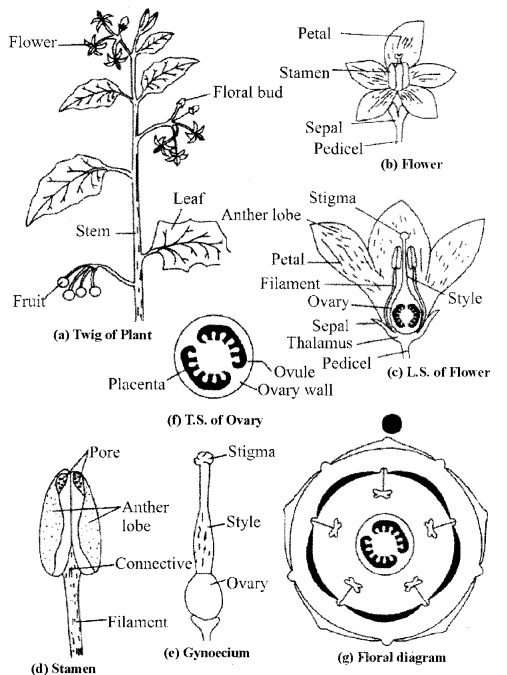
Floral structure and floral diagram of a typical plant (Solanum nigrum) of family Solanaceae.
10. Pollination :
- Entomophilous
- In potato (Solarium tuberosum) self pollination occur.
11. Distinguish Characters of Solanaceae
- Persistent sepals
- Epipetalous stamens
- Gynoecium is bicarpellary, bilocular, oblique ovary with swollen placentation.
- Bilobed stigma
- Berry or Capsule type of fruit.
Question 6.
Explain in detail Liliaceae family with its floral characters. Draw floral diagram and write floral formula. Write the botanical name of 5 economically important plants from this family.
Answer :
Floral Characters :
1. Inflorescence:
- It has various type of inflorescence.
- Racemose:-
Raceme- In Yucca, Asphodelus.
Spike- In Aloe
Umbel- In Smilex . - Cymose:-
Solitary terminal- In Tulipa, Lilium, Paris
Solitary axillary- In Gloriosa
Scorpioid cyme – Hemerocallis.
Monochasial cyme- In Allium the inflorescence is monochasial cyme but it looks like an umbel due to shortened inter nodes.
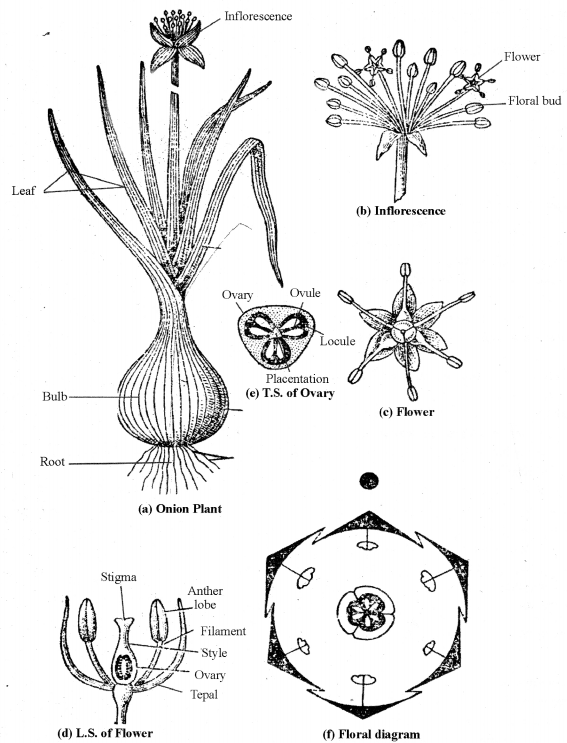
Floral parts and floral diagram of Allium lepa.
- Flowers are bracteate, pedicellate, complete, bisexual, actinomorphic, trimerous and hypogynous.
- Occasionally, the flowers are zygomorphic (e.g., Haworthict, Gillesia).
- They are unisexual and trimerous in Smilax and Ruscus.
- In Paris and Aspidiastra flowers are tetramerous and actinomorphic but in Aloe and Lilium zygomorphic.
2. Perianth :
- Perianth is composed of 6 tepals, arranged in two whorls of 3 each, (3 + 3).
- The tepals are polyphyllous (e.g., Allium, Asphodelus) or gamophyllous (e.g., Aloe,Polygonatum). They are petaloid and the aestivation is valvate or imbricate.
- In Gillesia tepals are ligulate.
- Tepals are usually petaloid in nature.
3. Androecium :
- There are 6 stamens arranged in two whorls of 3 each (3 + 3).
- They are polyandrous.
- The filament of stamens are either adnate to tepals Epiphyllous as in Allium, Asphodelus or free as in Smilax and oppositiphyllous.
- In tetramerous flowers 8 stamens arranged in two whorls of 4 each (4+4).
- In Ruscus 3 stamens are in synandrous condition.
- Anthers are dithecous, basifixed or dorsifixed and introrse.
- Occasionally, the stamens of the outer whorl are reduced or sterile (e.g., Ruscus).
4. Gynoecium :
- Gynoecium is tricarpellary, syncarpous, superior, ovary and trilocular with many ovules in each locule on axile placentation.
- Style is simple and stigma is trilobed.
- Usually a nectary’ is present on each septum of the ovary’.
6. Pollination : Entomophilous.
- In Yucca pollination takes place by a moth Pronuba yuccasella. It lays eggs in ovary of Yucca flower. It is an example of symbiosis.
7. Floral Formula :
![]()
8. Fruit :
- Simple-dry capsule.
- Loculicidal in Asphodilus or septicidal in Herreria.
- Berry in Simlax, Dracaena and Dianella.
9. Seed : usually albuminous in some exalbuminous also.
Distinguish Characters of Liliaceae
- Trimerous flower
- In Perianth – Tepals are petaloid and in two whorls.
- Stamens – Epiphyllous and in two whorls.
- Gynoecium – Tricarpellary with axile placentation.
- Fruit – Capsule